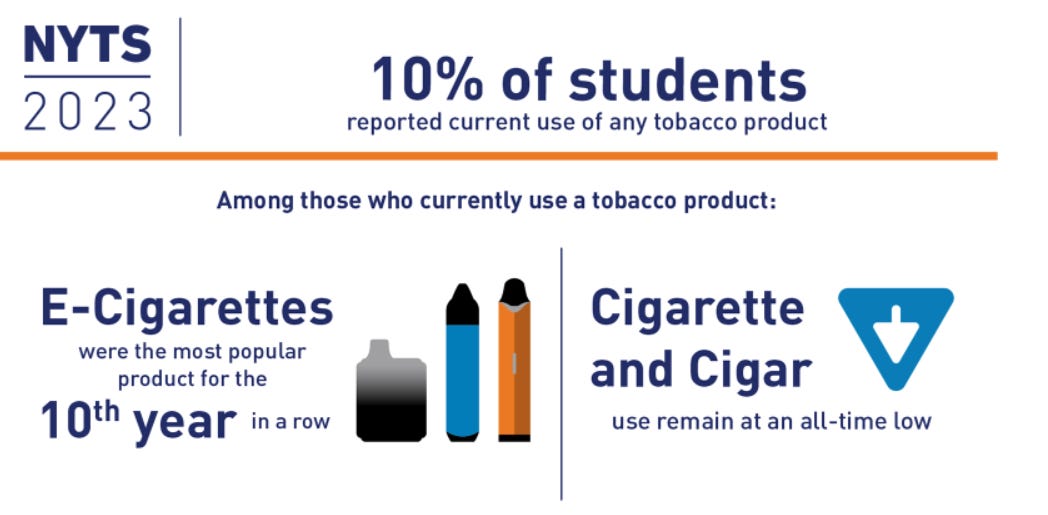Over the past decade, vape use has increased among young people in the US and is now far more popular than other types of nicotine or tobacco products.
Increase in Vaping Among Young People
According to the US National Youth Tobacco Survey of 2023, vapes (also called e-cigarettes) are by far the most popular nicotine or tobacco product among middle and high school students in the US, with about 7.7% of people (about 2.13 million) in this age group reporting current use. This is compared to 2011 rates, where about 1.5% of high school students and 0.6% of middle school students reported current vape use. Vaping is also the most popular form of nicotine or tobacco use today among 18-24 year olds.
In contrast, combustible cigarette use is at an all-time low, with just 1.6% of high school and middle school students reporting current use. Compared to 2011, the rate for high school students was about 21.8% and about 4.3% for middle school students.

Image credit: 2023 Findings on Youth Tobacco Use (https://www.fda.gov/tobacco-products/youth-and-tobacco/results-annual-national-youth-tobacco-survey)
Image note: “Students” here means middle- and high-school students.
Factors Contributing to Vaping Popularity
There are several reasons why vapes may be appealing to youth compared to other nicotine and tobacco products.
⚠️ Vape manufacturers use creative marketing and advertising strategies, including the use of enjoyable flavors, colors, and low pricing, to make vapes appealing to young people.
- One of the top ten reasons why young people report starting vaping is due to the attractive flavoring of the vapes. Sales of flavored e-cigarettes increased by 192% between 2020 and 2023, and 9 out of 10 youths who use vapes report using flavored vapes.
- Vape manufacturers have lowered the entry price by making disposable vapes, which are relatively cheap and therefore more appealing to young people.
⚠️Young people report starting and continuing to vape due to social influences. Most commonly, young people will try vaping for social acceptability, out of curiosity of others, or because of peer pressure.
⚠️ Repeated use can lead to dependence on the nicotine in vape products. Nicotine potency in some vapes, including disposable and flavored products, has risen over time. Considering the addictive nature of nicotine, a higher nicotine content might speed up the shift from experimental to routine use, potentially resulting in increased consumption over time. Even though there are vapes that do not contain nicotine, vaping nicotine-free products can still cause side effects.
Trends Over Time
A comprehensive commentary published in 2022 highlighted recent trends in vaping among young people in the U.S. In this commentary, the authors define “exclusive” use as the sole use of one product and not concurrently using more than one product. In 2011, about 0.5% of high school students were using a vape exclusively, while exclusive cigarette use was around 11%. By 2019, exclusive vaping rates were closer to 22%. Meanwhile, exclusive combustible cigarette use dipped to less than 1% — a record low. Since 2019, exclusive vape use among high school students has started to decline — rates in 2021 were about 9.8%. As mentioned previously, the vape use rate in 2023 was 7.7%, but this rate does not indicate exclusive use, meaning that these students may be using other nicotine or tobacco products in addition to vapes. Some speculate that the COVID-19 stay-at-home orders could have affected this, as students may have been under more careful watch from their families at home and may not have had access to purchasing vapes.
The same study and others show overall similar patterns among young adults aged 18-24. Vaping is now much more popular than combustible cigarettes in this age group. Compared to middle and high school students, one notable difference is that among young adults, vaping has continued to rise, even through the COVID-19 pandemic. As of 2021, about 11% of young adults report current use of nicotine vapes. Interestingly, among college students, vaping rates were even higher than the general population of young adults. In 2019, the vaping rate among college students was 22%, and the rate among non-college young adults was 18%. This difference suggests that there are subpopulations who are more inclined to use vapes.
Conclusion
Overall, there are various reasons why vaping rates are rising among young people. As with many health behaviors that are shaped by culture and social norms, the trends are complex and hard to predict. There are regulations from the FDA, FTC, and Bureau of Alcohol, Tobacco, and Firearms against the manufacturing, marketing, and sale of vapes to young people, but the effectiveness of such regulations is unclear and may come with trade-offs. Attempts to reduce youth vaping may make it more difficult for current smokers to use vapes to help them quit smoking.
This is the second in a series of posts about vaping. This one focuses on vaping nicotine products. We posted recently about the tradeoffs of using vapes versus combustible cigarettes. Please put your questions about vaping in our question box.
Stay safe, stay well,
Those Nerdy Girls
#ThoseNerdyGirls #vaping
Further Reading:
E-cigarettes: The Technology, the Market, and the Practice of Vaping
Current Electronic Cigarette Use Among Adults Aged 18 and Over: United States, 2021
Tobacco Product Use Among U.S. Middle and High School Students — National Youth Tobacco Survey, 2023
Vital Signs: Tobacco Product Use Among Middle and High School Students — United States, 2011–2018
Trends in Current Electronic Cigarette Use Among Youths by Age, Sex, and Race and Ethnicity
Tobacco Product Use Among Adults – United States, 2021
Balancing Consideration of the Risks and Benefits of E-Cigarettes


